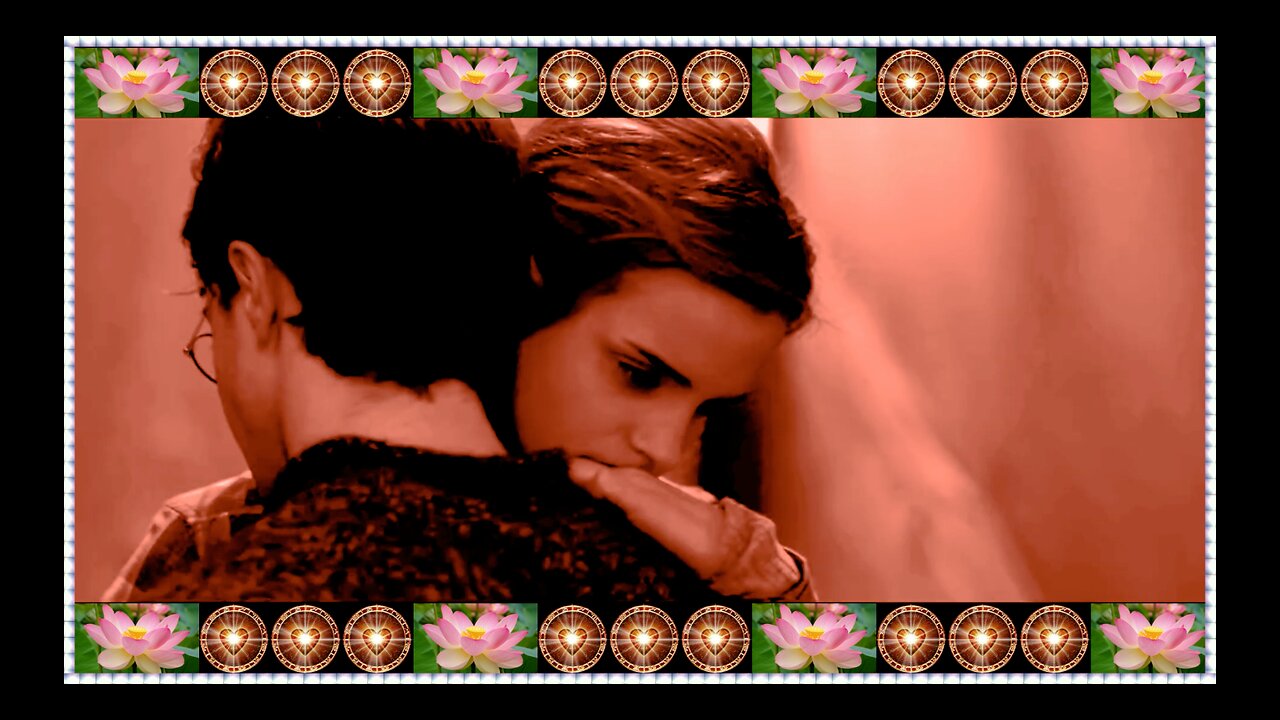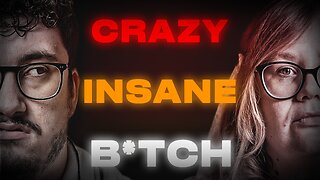Premium Only Content

HOLY SPIRIT OF DANCING ! = ELEVATING - ROMANTIC - EXCITING - UPLIFTING - LOVING !
Dancing is a wonderful art that is good for the soul. Dancing is good for the heart. Dancing, especially romantic dancing, is an expression of love, harmony and beauty that brings couples closer together and expresses joy and warmth.
Here is my film of today, on romantic and exciting dancing.
It begins with a song I sing, that I may have entitled, amusingly so:
I came into this world dancing straight out of my mother's sacred womb ...!
/=/
Dance has traditionally been an important part of religion and culture in India. Everybody in India loves to dance. In fact, to many, India is the country of dancing!
According to Indian legend, the gods invented dance.
Dancing is one of the most revered Hindu arts because it incorporates melody, drama, form and line.
Gestures, body positions and head movements are emphasized in Indian dance.
The use of the hands, fingers and eyes are of primary importance.
There are almost a thousand specific hand movements and signs (“mudras”.) Often bells are worn around the ankles.
/=/
The four “abhinovas” are essential to understanding Indian dance.
They are :
the technique of movement, which includes facial expressions, head movements and body movements;
2) all types of vocal and instrumental sounds linked with dance;
3) involuntary actions such as perspiration, trembling and blushing; and
4) make-up, costumes and sets. Some dancers are capable of changing their skin color voluntarily by consciously pumping blood into the capillaries on the face.
/=/
Gestures play an important role in India dance. Some dances feature more 600 gestures, each with a specific meanings. They often have a codified meaning that are known to the audiences that watch the dances. It haS been suggested that the codified developed as way convey a single message by dance troupes traveling through areas where different languages are spoken or they developed out mnemonic devises used by storytellers to convey and remember their stories. Colors are also rich in symbolism and meaning. Heavy eye make up is often worn to highlight the expressive of the eyes.
/=/
Importance of Dance in India :
Nataraja (a depiction of Shiva) is the divine, cosmic dancer and a classic image in Indian art. He is often depicted in old bronze statues with four arms and one legged raised and the other crushing Apasmara, a dwarf-demon associated with confusion and ignorance. One hand assumes the gesture of protection, one points to a raised foot, one hold the drum that keeps the beat of the rhythm of creation. The forth holds the fire of dissolution.
/=/
The ancient treatise on sculpture, the “Silpashastra”, offers a telling story about dance and art. In the old days a devout king from Vajra asked a the sage Markandeya to teach him the art of sculpture. The sage handed the king a lump of metal and asked him, “Do you know how to paint? The king said he didn’t but he was ready to learn. The sage then said, “Do you know how to dance?” The king said he didn’t but he had a basic knowledge of instrumental music. The sage then told him to learn more about music and use that to understand dance better and with that knowledge advance up the scale to painting and the sculpture. It is no wonder also that dancers and gods associated with dancing are the subjects of some of India’s greatest works, the Chola sculptures.
/=/
Dancers have traditionally been members of certain entertainer castes. They ranked low in the caste system and purity scale and supported themselves by working in traveling troupes or working for specific temples. It was not unusual for female temple dancers and troupe dancers to work as prostitutes. When the girls started leaving the temples to please local landlords a law was passed prohibiting the practice of dedicating girls to temples. To this day no mother in India wants her daughter to be dancer, because of its association with promiscuity.
/=/
Dr. Jukka O. Miettinen of the Theatre Academy of Helsinki wrote: “ The man who is regarded as being the first dancer to introduce the West to the “real” Indian dance tradition was Ram Gopal (1917–2003). In fact, his creations were only based on real Indian dance techniques, such as kathakali, bharatanatyam, and kathak, while the dance numbers themselves were mostly his own creations. Nonetheless, Ram Gopal was a remarkable dancer. He toured the world with his own company, for which he created short spectacular pieces. While they were based on Indian techniques he stripped them, at the same time, of their original costuming and make-up and gave them the fashionable “orientalistic” outlook, so popular in the West and by that time in India too.
/=/
History of Indian Dance :
Dances performed in India are said to have their origins in dances and rituals of the period of the Vedas, which date back to around 1000 B.C. The earliest Indian religious texts describe creation in terms of dance. In Hindu mythology, a dance by Shiva creates and destroys the universe. Caves in the Vindhya Hill region of Mardya Pradesh are filled with images made by hunter-gatherers of dancers in a rich array of positions, many of them sexual.
/=/
Dr. Jukka O. Miettinen of the Theatre Academy of Helsinki wrote: “The earliest known permanent settlements in India appeared approximately 9 000 years ago. They gradually developed into one of the earliest pre-urban civilizations in the world, the so-called Indus Valley Civilization, which flourished in approx. 2700–1800 B.C. Its centers were Harappa and Mohenjodaro in the Indus River Valley, in present-day Pakistan. The Indus Culture had its own writing system, which has not yet been deciphered. Two small sculptures give some information about dance of the period.
/=/
The oldest hard evidence of Indian dance are bas-relief depictions of dance found in Barhut, Sanhi and Amaravati, which date from the 2nd century B.C. to A.D. third century, and “Natyasastra” of Bharata, a treatise on drama and dance written between the A.D. 2nd and 4th century and sometimes referred to as the fifth Veda. Dance in India is guided by the elaborate codes in the Natya Shastra and by mythology, legend and classical literature.
/=/
Sculptures from all over India and from many different historical periods, many before A.D. 1000, illustrates the importance of dance in Indian cultural history and the richness of its traditions.
Many classical forms of dancers are based on ancient sculptures. Dance is believed to have evolved from religious rituals and shamanist practices. Even today religious rituals often have drama and dance as elements in them.
They are often associated with a particular Hindu god or a story or episode from the Ramayana and Mahabharata and are done n conjunction with music and art.
Dr. Jukka O. Miettinen of the Theatre Academy of Helsinki wrote: “ The man who is regarded as being the first dancer to introduce the West to the “real” Indian dance tradition was Ram Gopal (1917–2003). In fact, his creations were only based on real Indian dance techniques, such as kathakali, bharatanatyam, and kathak, while the dance numbers themselves were mostly his own creations. Nonetheless, Ram Gopal was a remarkable dancer. He toured the world with his own company, for which he created short spectacular pieces. While they were based on Indian techniques he stripped them, at the same time, of their original costuming and make-up and gave them the fashionable “orientalistic” outlook, so popular in the West and by that time in India too.
/=/
Dance, Sculpture and Art in India :
Dr. Jukka O. Miettinen of the Theatre Academy of Helsinki wrote: “ Besides the early literature, the visual arts, such as early sculptures, reliefs, and later paintings, also give extremely valuable information about theatre and dance. In India the whole phenomenon of the interrelation of dance and the visual arts, and indeed of other art forms as well, is a most crucial one. The question is not merely of borrowing and exchanging materials and ideas from one art form to another. In Indian thought, dance, and all art, is basically a religious sacrifice (yajna). Art is also regarded as a form of yoga and a discipline (sadhana). Through the creation of a work of art the artist/craftsman strives to evoke a state of pure joy or bliss (ananda).
/=/
“The human body was seen as a vehicle of worship and thus performances become acts of invoking the divine. By 200 AD at the latest, as stated above, the complicated techniques of dance-like acting, as well as the rasa system, were codified in the Natyashastra. It is significant that in the Indian tradition it is dance, a temporal and corporal form of art, which is regarded as the ascendant art form. It set the measure for other forms of art, since they adopted the theory rasa from the tradition of the Natyashastra.
/=/
“Dance has been so predominant in its position that some textual sources stress that sculptors and painters cannot succeed in their work without a basic knowledge of it. The Natyashastra sets the physical and dramatic tools for evoking the rasa or the emotional state appropriate to worship. On the other hand, the Silpashastras, manuals of iconography and sculpture, were intended to help in producing the corresponding figurative representations.
/=/
“Consequently, the principles of movement, however complicated they may be, are the same for both a dancer and a sculptor. The final goal of this intricate science of movements, measurements, poses, gestures etc. is to create the rasa, the actual object of presentation and, finally, to reach even further in evoking the state in which transcendental bliss can be experienced.
/=/
Shiva, Religion and Dancing Gods in India :
Dr. Jukka O. Miettinen of the Theatre Academy of Helsinki wrote: “All the three Indian religions, Hinduism, Buddhism and Jainism, share the same theoretical basis for dance and the visual arts. And so most of the margi or “classical” dance techniques, in spite of their local stylistic variations, bear strong similarities in all of these three traditions.
Consequently, their imagery shares common aesthetic norms and iconographic features. As early as from the Vedic period (1600–550 B.C.) onwards, Indian literature and mythological narrative created characters which were depicted in the visual arts as dancing or in easily recognizable dance-derived poses, reflecting the prevalent dance techniques.
/=/
“During the classical Gupta age from the fourth to the sixth century AD the repertoire of the dance images expanded further, while the Puranas or mythological stories of the early centuries AD provided more dance-related imagery. Along with dancing human beings and semi-gods of older periods appeared dancing gods, the first of them being the dancing Shiva.
/=/
“The sculpture-type called Shiva Nataraja can be regarded as one of the trademarks of Indian art. The iconography of the Shiva Nataraja, literally meaning the King of Dance, developed over the centuries and reached its crystallized form in Tamil Nadu during the Chola period in approximately the 10th–12th centuries AD. It was the very period when the art of bronze casting reached its apogee. The Chola sculptors were able to reproduce, in metal, the exact proportions laid down by the Silpashastras and even the tiniest details of the gestures and movements dictated by the Natyashastra.
/=/
“The Shiva Nataraja represents Shiva as the destroyer/creator as described by devotional poetry dedicated to him. In the Hindu cyclical view of time Shiva’s role is to destroy one era in order to create the next one, and this is what Shiva Nataraja statues portray. When he executes his cosmic tandava dance of destruction and creation he is surrounded by an arch of glory fringed by flames.
/=/
“The flame that he is holding in his upper left hand hints at the aspect of destruction, while the drum, symbol of the pulse of life, which Shiva holds in his upper right hand, refers to the aspect of creation. The lower left hand points to his lifted foot, while the lower right hand is shown in pataka mudra. Multi-handedness, a feature typical of many nrttamurtis, is a practical way to manifest the deity’s different aspects simultaneously. It also enables the sculptor to capture several frozen moments of a movement sequence in a static sculpture.
/=/
“The main characteristic of Shiva’s dance in the Chola iconography is the uplifted leg. His right leg is firmly planted on a dwarfish creature, which personifies one of the six enemies of enlightenment. The sculpture is full of symbolism. Shiva’s braided hair is often decorated with his attributes: a laughing skull, a crescent moon and a cobra, and also often Ganga, the personification of the Ganges. The rasa, which Shiva’s dance always evokes, is raudra, the Furious.
/=/
Dance Images in Indian Temples :
Dr. Jukka O. Miettinen of the Theatre Academy of Helsinki wrote: “ Many of the early Buddhist reliefs with their dance-related images and the early dance images of Hindu cave temples are still in their original architectural contexts. The earliest surviving free-standing stone temples were built in the Gupta period. Gradually their plain outer walls were decorated with narrative panels as well as dancing divinities. This was the beginning of a development that was to lead to the flourishing of dance images in Hindu temple architecture during the so-called “medieval” period, approximately from the 7th to the 16th century.
/=/
“The most abundant representations of dance images can be seen in the Hindu temples of South India, in the Bhubaneshwar temples in East India, and in the temples of Khajuraho in Central India. The West Indian Jain temples of Mt. Abu are also famous for their dance imagery. The styles of sculpture differ and local schools can easily be recognized, but the fundamental portrayal of the movement is mostly rooted in the tradition of the Natyashastra.
/=/
“Series of dance reliefs directly related to the Natyashastra can be found in some medieval temple complexes in South India. The most famous of them are those carved on the towering 9th century gateways of the Shiva temple in Chidambaram. They include ninety-three of the 108 karanas described in the Natyashastra. These small relief panels, together with other similar series and contemporaneous murals depicting dancers, constitute an important source material when one is trying to reconstruct the karana movement cadences of the Natyashastra. What makes these Chidambaram karana reliefs so particular is that they are accompanied by inscriptions of Sanskrit verses from the Natyashastra. Thus they form a kind of an illustrated dance manual carved in stone.
/=/
“Since the karanas have practically disappeared from the present Indian dance styles it is understandable that the academic study focusing on these reliefs has already had a long tradition. By means of these reliefs and their inscriptions scholars and dancers have tried to reconstruct the ancient karanas since the early 20th century. Each panel shows one dancer in one frozen moment of a movement pattern. This led the early scholars to believe that karanas were actually static poses, an assumption which later research has renounced. The debate focusing on these panels has been very lively and has led to several attempts to reconstruct the karanas.”
/=/
Balasarasawati and the Guru Institution :
Dr. Jukka O. Miettinen of the Theatre Academy of Helsinki wrote: “ Before the founding of dance and theatre institutions and schools in the early 20th century, the classical music, acting and dance traditions were taught by masters or gurus. The so-called guru-sishya system of education indicates a close personal contact between a master and his pupil. During daily contact the master guides and initiates his student into the secrets of the art according to his pupil’s abilities and spiritual development.
/=/
“When revivalists around India, such as Rukmini Devi, Rabindranth Tagore and others, started the revival of the traditional performing arts it was the old guru families and lineages they turned to. The level of dance performances may have declined in some parts of India, but the skills and knowledge of these traditions were still preserved by the guru families. Thus the revivalists invited prominent gurus to teach new generations of artists at their modern institutes. This is, in fact, still often the case in modern art universities as well. Even today most of the serious actors and dancers working in the traditional fields of the performing arts privately continue their studies, throughout their careers, with their chosen gurus.”
/=/
“Some dancers themselves were also bearers of age-old traditions. One of them was Balasaraswati (1918–84), a remarkable exponent of bharatanatyam in the seventh generation. She belonged to a family of dancers based in Tanjavur and made her debut in 1925. She was invited to work at Rukmini Devi’s Kalakshetra institution and she thus deeply influenced the revival of bharatanatyam. She was renowned particularly because of her deep and nuanced abhinaya mime acting and she has been regarded as “the greatest single repository of the performing arts of southern India”.
/=/
Mujra Dancing and Ladies Clubs :
Ladies bars are a unique Bombay institution, with women singing and dancing for wealthy men in what has been described as a “Bollywood fantasy in a South Asia palace.” Women dance, often after saying a prayer, and men often even throw cash from their seats. It is forbidden for men to solicit the women but it is regarded as acceptable for them to try to get a woman’s phone number and meet her outside the club.
/=/
Somini Sengpata wrote in the New York Times: “ A dozen women in shimmering chiffon skirts swayed their hips, lip-synched and gazed a themselves in the mirrored walls...In one corner of the bar, a man kept his attention and his money focused on a languid young woman in yellow. She moved to the music, threw back her hair, admired herself in the mirror and responded to his invitations to move closer, each time fattening the stack of bills in her hand.” In 2005, conservative Bombay officials with connection the Hindu nationalist group Shin Shiva threatened to close the bars down on the grounds that they promoted prostitution, corrupted young people and threatened family life.
/=/
Prostitution in South Asia has traditionally been associated with mujra dancers found at carefully hidden bars advertised by word of mouth. Mujra, or courtesan clubs, have traditionally been associated with men’s nights our during the Eid festival that marks the end of Ramadan. The custom is most alive in Lahore, which has a reputation of being more open and liberal than other places in Pakistan.
/=/
Mujra is derived from Kathhak classical dancing. Kathhak dancers enjoyed high status in the Mughal era and often entertained members of the court. There were so many of them at that time they formed their owned caste. The remnants of this caste, many of them illegitimate children born to mujra, are linked with an alternative community of artists and poets that hang around the Diamond Market in Lahore.
/=/
Mujra dancers do not perform a strip tease act or anything like; they simply dance, often shaking their bottoms and breasts and wearing bells around their ankles. Maureen Paton wrote in the Times of London: women “wearing leather ankle straps hung with bells below their traditional costumes of tunic and leggings, will simply mime to film music … As a signal to show his appreciation, a man will toss a £5 or £10 note in the direction of his chosen girl. And after the performance is over, sexual services are bought and sold in an adjoining room. Nothing needs to be spelled out: it is understood that sex, if the client wishes, is part of the equation.”
/=/
Whittaker Khan, a British-Pakistani woman who wrote a play about mujra dancers, told the Times of London, “They never take off their clothes during the performance because the culture is so repressed. But dancing is so associated now in Pakistan with prostitution that it is difficult to practice it purely as an art form; and men from respectable families don’t marry such girls.”
/=/
Types of Dance :
Both classical and folk forms of dances are performed in India. Dances forms vary, especially between the north and south. Indian dances are divided into three types:
1) “nrtta” (rhythmic dancing without a story);
2) “nrtya” (dramatic dancing with a narrative or descriptive theme);
3) “natya” (acting).
/=/
All forms have traditionally been structured around the nine “rasa” (emotions):
“hasaya” (happiness);
2) “shoka” (sorrow);
3) “krodha” (anger);
4) “karuna” (compassion);
5) “bhibatsa” (disgust);
6) “adhbhuta” (wonder);
7) “bhaya” (fear);
8) “viram” (courage); and
9) “shanta” (serenity).
/=/
The are four main schools of Indian dance :
“Bharata natyam” (a southern dance form which features women dancers doing a wide variety of dance movements accompanied by the rhythm of her stamping feet);
2) “Kathakali” (a southern dance from Kerala area featuring men doing martial arts like movements to the rhythm of drums);
3) “Kathak” (a northern dance done by women and men to the rhythm of feet slapping on the ground);
4) “Manipuri” (a dance from the Assam area of the northeast India with graceful swaying movements).
/=/
Classical dance forms have rigid rules for presentations.
Classical dancers are known for angular posture, strange hand positions and strange facial expressions, tinkling ankle bells, feet smacking the floor, cocked heads, and hands bent upwards in awkward positions.
/=/
Among the leading forms of classical dance are Bharata, Natyam, Kathakali, Kathak, Manipuri, Odissi, Kuchipudi and Mohini Attam.
/=/
Dance is a great form of exercise because it is a low-impact activity. This means that it does not put excessive strain on your muscles and joints.
/=/
It also makes you feel more limber and releases endorphins to make you feel happier.
/=/
In addition, there are many different types of dance, so it’s easy to find something that suits your mood at the time. The best part about dance is that it’s never too late to start, anyone can learn how to dance.
/=/
There are so many great online resources available for dancers looking for new moves or techniques.
If you’re feeling overwhelmed by all the choices out there, just remember this one simple truth: You can’t go wrong with anything as long as you’re having fun and moving your body around.
/=/
Dancing in India makes them happy
Dance in India makes them healthier than those who don’t dance.
Dance lessens their anxiety
Dancers develop focus
Dancers have better balance
Dancing is a form of exercise that can help people with coordination.
/=/
Dancing to music helps people move in time with the rhythm, which improves their sense of timing and increases their ability to keep a beat. It also strengthens muscles, improves balance, and helps burn calories.
/=/
People who have issues speaking because they are autistic or have cerebral palsy may also find it easier to communicate through dance.
/=/
In developing countries like India, young girls sometimes don’t go to school because they have no way to get there and so work instead as household servants.
However, with a bit of money for lessons, these girls could be trained as professional dancers and use their skills to improve their own lives as well as contribute to the economy by teaching other children in school.
/=/
Dancing in India makes them happy
Dancing is a way for people to express themselves. It’s a way to release built-in tensions and can be a great way to strengthen relationships with other people.
/=/
Dancing is important in many cultures, but it might mean something different from culture to culture.
/=/
For example, some cultures may use dancing as a form of religious worship or prayer while others use dance as a form of storytelling.
/=/
In India, for example, folk dances are often used for storytelling about the local gods and goddesses.
/=/
There are two main types of Indian dance: classical and folk.
/=/
Classical dancers train extensively in order to create beautiful choreography that depicts stories from ancient texts.
/=/
Folk dancers train less intensively, and their movements mimic everyday tasks such as farming or weaving cloth, which represents their day-to-day lives.
Dances vary by region within India, because each region has its own stories to tell about its gods and goddesses.
/=/
Dance in India makes them healthier than those who don’t dance
Dance not only makes you healthier and more energetic, but it also has a positive impact on your mental health. Dancers are less likely to experience depression or anxiety than those who don’t dance.
/=/
Dance helps people manage stress better, sleep better, and be more flexible. It also lowers blood pressure and strengthens the immune system.
/=/
Those who do dance have been found to have lower rates of heart disease, cancer, and diabetes than those who don’t dance!
/=/
Not to mention that dancing is just plain fun you can never resist tapping me when you hear good music or watch an interesting new dance step performed by someone else, which makes the power of dance an undeniable pleasure you should give it a try
/=/
Dancing has been shown to reduce anxiety, which is especially beneficial for people who suffer from panic attacks and other severe anxiety disorders. Dancers feel less anxiety because the physical movements help them distract themselves from the thoughts that are causing their fear.
/=/
They also don’t have time to think about any issues they’re experiencing when they’re immersed in the music and moving their bodies to express themselves.
/=/
When you’re feeling anxious, try getting up and moving your body for a few minutes. It doesn’t matter if it’s in your living room or at the grocery store, anything that gets your blood pumping and forces you to focus on what’s happening right then will be helpful.
/=/
If possible, find an activity like dancing that really gets you going! It can be an effective form of therapy without having to talk with a therapist.
/=/
Dancing develops a dancer’s focus and teaches the importance of self-expression. Dancers learn to look at their own bodies and think about what they want to do, where they want to go, and how they will get there.
/=/
This self-awareness is useful as dancers grow into adults and have more control over their lives. The need for independence also increases with age. Dancing can teach this skill early on so that people don’t have to find out later on in life.
/=/
Furthermore, it helps children develop decision-making skills when they must decide which moves they should use while dancing and when. For example, some dances require fast steps while others require slower ones.
/=/
Lastly, dance in India is not only important because it teaches personal expression, but it has been an ancient way to worship gods like Shiva or Kali. Even today many people still perform Hindu temple dances called Nrittya Natya (Natya means drama) in order to express themselves through dance
/=/
Dance is not just a form of expression and entertainment, it also has physical and mental benefits.
/=/
Dancers have better balance, an enhanced sense of rhythm, better coordination, improved motor skills, and enhanced social skills. It has been seen that dance therapy can help patients with Parkinson’s disease or Alzheimer’s by increasing their muscle control.
/=/
Dancing can also be used to help people overcome depression or addiction problems. For children, dance has been shown to improve their reading comprehension, math abilities, self-confidence, and concentration.
/=/
A study from the University of Illinois at Urbana-Champaign showed that children who take part in weekly dancing lessons scored higher on standardized tests than those who didn’t take part. The power of dancing lies in its ability to help children develop as well as provide them with ways for expression.
/=/
Dance is an important part of Indian culture. It is used for many different purposes, from celebrating the victory of a victorious warrior to showcasing the beauty and talents of women.
/=/
Dancers are considered respected members of society and it is not uncommon for girls to dance at their weddings or for married women to practice dance with their mothers-in-law.
/=/
While there are many types of dances in India, Bhangra (a type of dance that originated in Punjab) has become popular throughout the world.
/=/
What is the importance of dance?
Dance is an important part of many cultures and has been a form of expression for people since the beginning of time.
/=/
Dancing is not just about movement; it’s also about storytelling, communication, and emotion. Dancing is used as a form of entertainment, celebration, and even worship.
/=/
There are many forms to dance: ballet, jazz, hip-hop, Latin dance styles, and more. All around the world, different types of dance have developed from traditional dances that have been passed down from generation to generation. Some examples include Salsa, Belly dancing, and Jive.
/=/
What is the value of dance?
Dance is one of the most ancient forms of art and entertainment. It is an integral part of the culture, history, and society in India. It is believed that dance originated as a form of worship to the gods and goddesses.
/=/
There are many types of dances such as classical dance, folk dance, tribal dance, bhangra, etc. While all types are equally popular, Bharatanatyam is one type that has a lot more relevance to Indians.
/=/
In fact, it is estimated that there are 10 million dancers who learn Bharatanatyam each year. The word Bharatanatyam actually means beautiful-soul-entertainment.
/=/
The name captures the spirit of this dance form which was once performed exclusively by women in temples and royal courts but has now become an integral part of everyday life for people from every walk of life.
/=/
Dance is a powerful form of expression. In ancient times, dance was used to convey messages or tell stories.
/=/
Today, many people use it as a form of self-expression and to build a sense of community with others who enjoy the same dance style. One such group is the Indian Diaspora Community in North America and Europe.
A common form of dance among this group is Bharatanatyam, which originated in Tamil Nadu, India.
Conclusion : DANCE ! DANCE ! DANCE !
/=/
/=/
/=/
FAIR USE - Section 107 of the Copyright Act 1976
This is a non-profit video that I personally composed solely for the purpose of study, review, research, self-expression, experimental analysis, creative research, humorous contrasting, cultural and educational philosophy, and basically for the love of artistic creativity itself, without any intention for any commercial uses whatsoever, and fully and absolutely for non-profit public display.
This video is for educational purposes only; and is offered freely to the public.
In composing this audio-visual film video, I am respecting the Copyright Disclaimer Under Section 107 of the Copyright Act 1976, whereby allowance is made for fair use, for purposes such as criticism, comment, news reporting, teaching, scholarship and research.
Fair use is a use permitted by copyright statute that might otherwise be infringing.
Non-profit, educational, or personal use, thankfully tips the balance in favor of fair use, thus promoting both the original work and other possible creative derivatives.
I made use of images in this composition that do belong to other film and music production firms. However, such a composition is unique and original in its full assembly, and is for educational and non-profit purposes only.
The original film production images and original music melodies in this film remain the property and copyright of its rightful owner, or owners.
I claim no ownership whatsoever on any of the materials I have used in creating this new audio-visual composition, except those that are my own to improve the state-of-the-art, and that I offer freely to the public worldwide.
Long Live Dancing !
Sincerely,
Teri'irere Ito'arai
Film Composer
=}
FAIR USE - Section 107 of the Copyright Act 1976
{=}
This is a non-profit video that I personally composed solely for the purpose of study, review, research, self-expression in the manifestation of beauty and wisdom, experimental analysis, creative research, humorous contrasting, cultural and educational arts and sciences synthesis; and basically for the love of artistic creativity itself, without any intention for any commercial uses whatsoever - and fully and absolutely for non-profit public display.
This video is for educational purposes only; and is offered freely, with my respect and love for the people of all sovereign cultures of the world.
In composing this audio-visual film video, I am respecting the Copyright Disclaimer Under Section 107 of the Copyright Act 1976, whereby allowance is made for fair use, for purposes such as criticism, comment, news reporting, teaching, scholarship and research.
Fair use is a use permitted by copyright statute that might otherwise be infringing.
Non-profit, educational, or personal use, thankfully tips the balance in favor of fair use, thus promoting both the original work and other possible creative derivatives.
I made use of images in this composition that do belong to other film and music production firms. However, the resulting audio-visual composition is unique and original in its full assembly, and is for educational, inspirational and non-profit purposes only.
The original film production images and original music melodies in this film composition, remain the property and copyright of its rightful owner, or owners.
I claim no ownership whatsoever on any of the materials I have used in creating this new audio-visual composition, except those that are my own to improve the cinematographic or musical state-of-the-art, or of my own speaking or singing voice, or of my own textual dialogues and photographies - and that I offer happily to the public worldwide, for their enjoyment of the fine arts of cinematography, photography, music, beauty, love and philosophy.
Sincerely,
Teri’irere Ito’arai - ( Henrik ! )
Film composer & amateur singer & orator
holyspiritofindia@protonmail.com
The Holy Spirit of Dancing !
The Holy Spirit of Wisdom !
The Holy Spirit of Love !
The Holy Spirit of Truth !
The Holy Spirit of Beauty !
The Holy Spirit of Life !
The Holy Spirit of India !
The Holy Spirit of Singing !
The Holy Spirit of Heroism !
The Holy Spirit of Martial Arts !
The Holy Spirit of Sports !
The Holy Spirit of Humour !
The Holy Spirit of America !
-
 LIVE
LIVE
The Mel K Show
1 hour agoMORNINGS WITH MEL K -Won’t Be Fooled Again? America Must Know the Hidden Truth About Post WWII Globalization 9-8-25
813 watching -
 LIVE
LIVE
The Shannon Joy Show
1 hour agoThe Vaccine Wars Intensify - DeSantis & Ladapo To END Medical Mandates - Trump Slams Initiative
192 watching -
 LIVE
LIVE
Grant Stinchfield
1 hour agoIf the Races Were Reversed… It’d Be National News, But White Victims Don’t Fit the Narrative
124 watching -
 3:28:16
3:28:16
Right Side Broadcasting Network
5 hours agoLIVE REPLAY: President Donald J. Trump Delivers Remarks to the WH Religious Liberty Commission - 9/8/25
41.9K16 -
 1:01:19
1:01:19
VINCE
3 hours agoNightmare In North Carolina | Episode 120 - 09/08/25
158K146 -
 1:49:43
1:49:43
Dear America
4 hours agoRepeat Offender Kills a Woman on a train!! WHY IS MSM SILENT!? + Are We Attacking Cartels??
99.2K77 -
 LIVE
LIVE
Viss
2 hours ago🔴LIVE - How To Win! - PUBG 101
106 watching -

Caleb Hammer
13 hours agoMost Batsh*t Insane Woman I’ve Ever Met | Financial Audit
17.2K -
 1:47:11
1:47:11
Badlands Media
11 hours agoBadlands Daily: Sept. 8, 2025
51.9K17 -
 LIVE
LIVE
Total Horse Channel
15 hours ago2025 Reno Snaffle Bit Futurity | Monday
30 watching